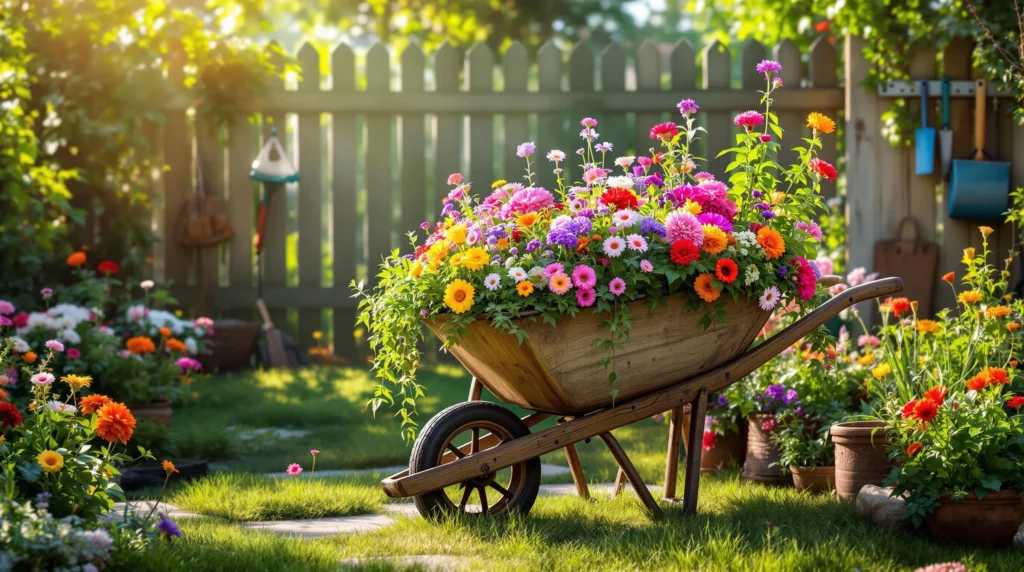10 Rustic Wheelbarrow Planter Ideas to Transform Your Garden
1. Vintage Wooden Wheelbarrow Herb Garden
Transform an old wooden wheelbarrow into a charming herb garden by filling it with nutrient-rich soil and planting basil, rosemary, thyme, and mint. Position your herb wheelbarrow near your kitchen door for easy access while cooking. The weathered wood adds rustic appeal while the elevated design keeps herbs safe from garden pests.
2. Cascading Flower Display
Create a stunning visual effect by arranging cascading flowers like petunias, lobelia, and verbena to spill over the sides of your wheelbarrow. Plant taller flowers like salvias or cosmos in the center and shorter, trailing varieties around the edges. This arrangement produces a waterfall of blooms that adds ever-changing movement to your garden space.
3. Succulent Showcase
Fill your wheelbarrow with sandy, well-draining soil and arrange a collection of drought-resistant succulents in interesting patterns. Mix varieties like echeverias, sedums, and haworthias for different textures and colors. This low-maintenance display works beautifully in sunny spots and requires minimal watering once established.
4. Seasonal Bulb Display
Plant layers of spring bulbs like tulips, daffodils, and hyacinths in your wheelbarrow during fall. When spring arrives, you’ll enjoy waves of colorful blooms. Once the spring show ends, replace with summer annuals for continuous color throughout the gardening season.
5. Miniature Fairy Garden
Transform your wheelbarrow into an enchanted fairy garden complete with tiny houses, miniature pathways, and diminutive plants. Use small-leaved plants like baby tears, miniature ferns, and dwarf herbs to create the perfect scale. Add tiny accessories like benches, bridges, and fairy figurines to complete this whimsical garden feature.
6. Vertical Garden Integration
Position your wheelbarrow beneath a trellis or garden arch and plant climbing vines like clematis, morning glory, or climbing roses. The wheelbarrow serves as the anchor planting while the climbers create vertical interest as they grow upward. This combination maximizes your garden’s vertical space.
7. Water Garden Feature
Line your wheelbarrow with pond liner and create a mini water garden with aquatic plants like water lilies, floating hearts, and water lettuce. Add a small solar-powered fountain pump for gentle water movement. This unique water feature brings soothing sounds and attracts beneficial wildlife to your garden.
8. Rustic Tiered Display
Create a multi-level garden feature by positioning your wheelbarrow as the centerpiece of a tiered arrangement. Place it atop a slight mound, surrounded by ground-level plantings and smaller containers. This layered approach adds depth and dimension to your garden design while making your wheelbarrow planter a focal point.
9. Farmhouse Vegetable Patch
Use your wheelbarrow’s depth for growing compact vegetables like cherry tomatoes, lettuce, radishes, and bush beans. The mobility of a wheelbarrow lets you roll your vegetable garden to the sunniest spots throughout the day. Add a trellis at the back for vertical-growing vegetables like cucumbers or peas.
10. Seasonal Decorative Display
Use your wheelbarrow as a constantly evolving garden feature by changing its contents with the seasons. Fill with pumpkins, gourds, and mums in fall; evergreen boughs and berries in winter; spring bulbs and primroses in spring; and colorful annuals in summer. This adaptable display keeps your garden looking fresh year-round.
Selecting the Perfect Wheelbarrow for Your Planting Project
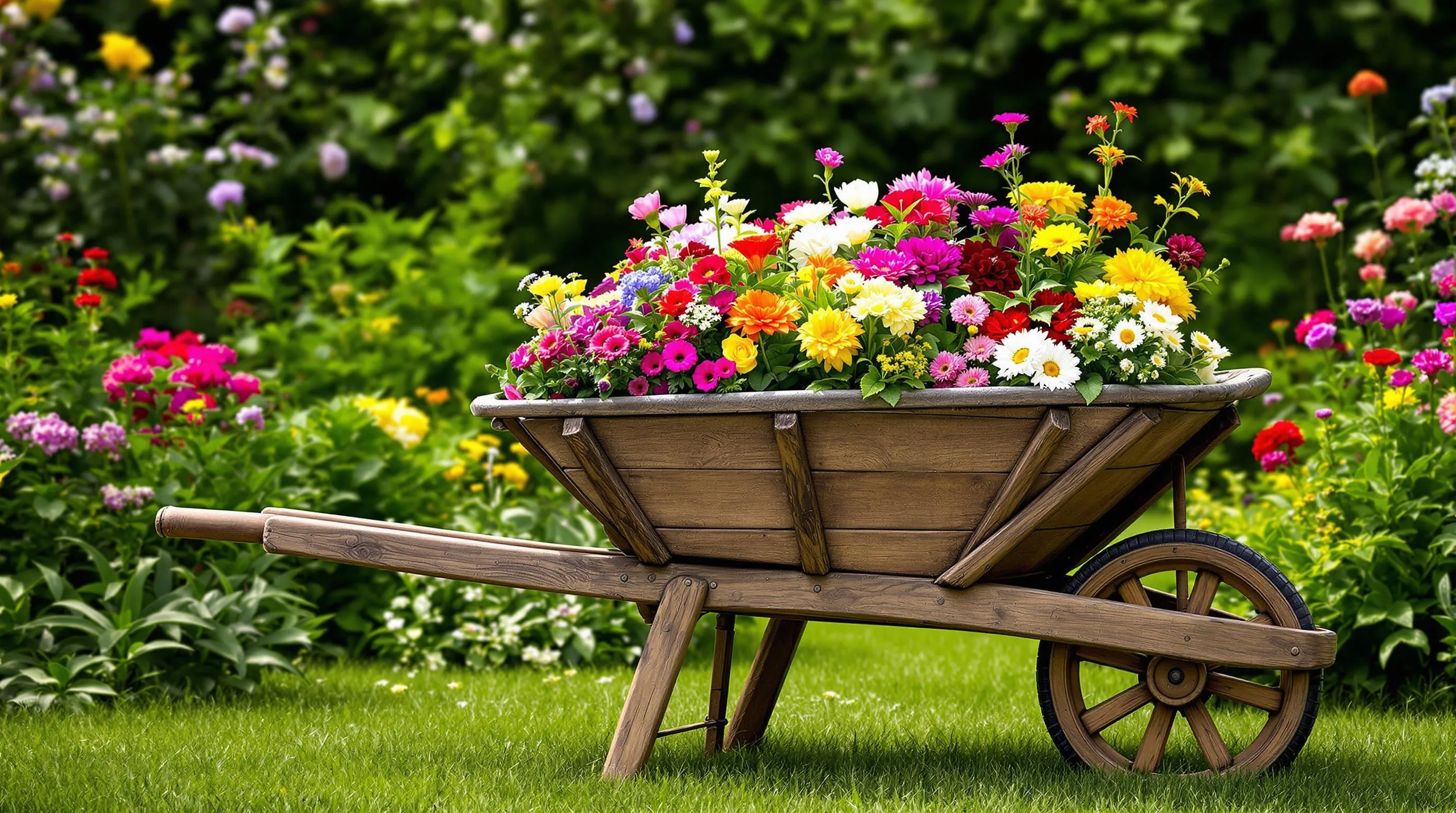
The foundation of a stunning wheelbarrow planter lies in choosing the right vessel for your garden vision. Your selection will influence not only the aesthetics but also the longevity and functionality of your planter.
Wooden vs. Metal Wheelbarrows: Pros and Cons
Wooden wheelbarrows offer natural charm and rustic appeal that’s perfect for cottage garden aesthetics. They’re lightweight, easier to position, and develop character as they weather. But, they require more maintenance with regular sealing or staining to prevent rot and may have shorter lifespans in wet climates. Metal wheelbarrows, particularly galvanized steel models, deliver industrial flair and exceptional durability. They resist weather damage, hold more soil weight, and can last decades with proper care. The drawbacks include potential rust issues if the protective coating is compromised and greater weight that makes repositioning more challenging. For contemporary garden designs with bold color schemes, consider powder-coated metal wheelbarrows that combine modern aesthetics with weather resistance.
Salvaging Vintage Wheelbarrows for a Timeless Look
Vintage wheelbarrows bring authentic character and history to your garden that new models simply can’t match. Look for old farm wheelbarrows at estate sales, flea markets, antique shops, or online marketplaces where prices typically range from $50-200 depending on condition and age. When evaluating a potential purchase, check for structural integrity in the handles and basin while remembering that surface rust or weathered wood can actually enhance the visual appeal. Minor repairs like replacing rotted wooden parts, reinforcing joints, or sealing small holes in metal basins are often simple DIY fixes. For preservation, apply linseed oil to wooden elements and rust converter followed by clear sealant to metal components. The patina of decades of use creates a storytelling element that makes these reclaimed treasures the perfect centerpiece for cottage gardens or farmhouse landscapes.
Creating a Cascading Flower Display in Your Wheelbarrow
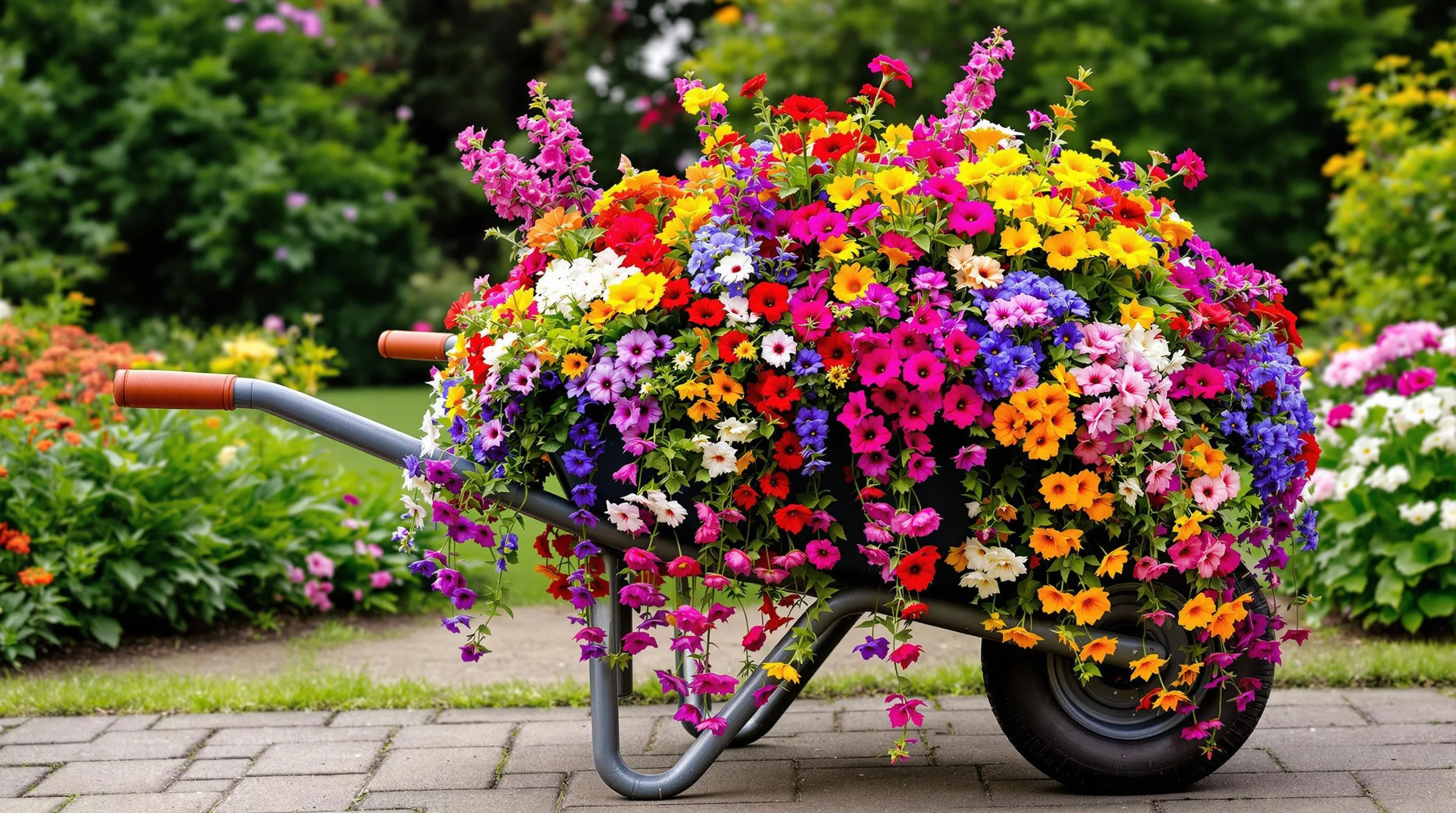
Transform your wheelbarrow into a stunning waterfall of blooms that adds vertical interest and movement to your garden space. The unique curved shape of a wheelbarrow creates the perfect platform for cascading plants to spill over the edges, creating a lush, abundant display that catches every eye.
Best Trailing Plants for Dramatic Wheelbarrow Effects
For maximum impact, choose plants with long trailing habits that will create that desired waterfall effect. Calibrachoa (million bells) offers continuous small petunia-like blooms in vibrant colors throughout the season. Wave petunias deliver impressive trails up to 4 feet long with weather-resistant blooms. Sweet potato vine adds dramatic chartreuse or purple foliage that quickly spreads up to 6 feet. Lobelia produces delicate blue or white flowers that create airy cascades perfect for softening edges. For texture variety, incorporate trailing varieties of ivy, vinca, or dichondra ‘Silver Falls’ with its striking silvery foliage. In partially shaded locations, try begonia boliviensis varieties like ‘Bonfire’ or ‘Santa Cruz’ for their dramatic orange-red tubular flowers that trail up to 2 feet.
Seasonal Color Combinations That Pop
Create visual excitement with strategic color pairings that change with the seasons. For spring, combine trailing purple pansies with yellow bidens and white bacopa for a fresh, cheerful display. Summer calls for bold combinations—try red calibrachoa with blue lobelia and silver dichondra for a patriotic theme. For fall displays, pair orange trailing lantana with purple verbena and silvery helichrysum for warm, autumnal tones. Change your color scheme based on holidays or events—pink and white combinations for weddings, orange and purple for Halloween, or red and white for winter celebrations. For year-round interest, incorporate evergreen trailing plants like ivy or creeping jenny as a foundation, then swap out seasonal bloomers as needed. Remember to position taller plants toward the back of the wheelbarrow and shortest at the front edge to maintain visibility of all your carefully selected varieties.
Herb Garden Wheelbarrow Designs for Kitchen Enthusiasts
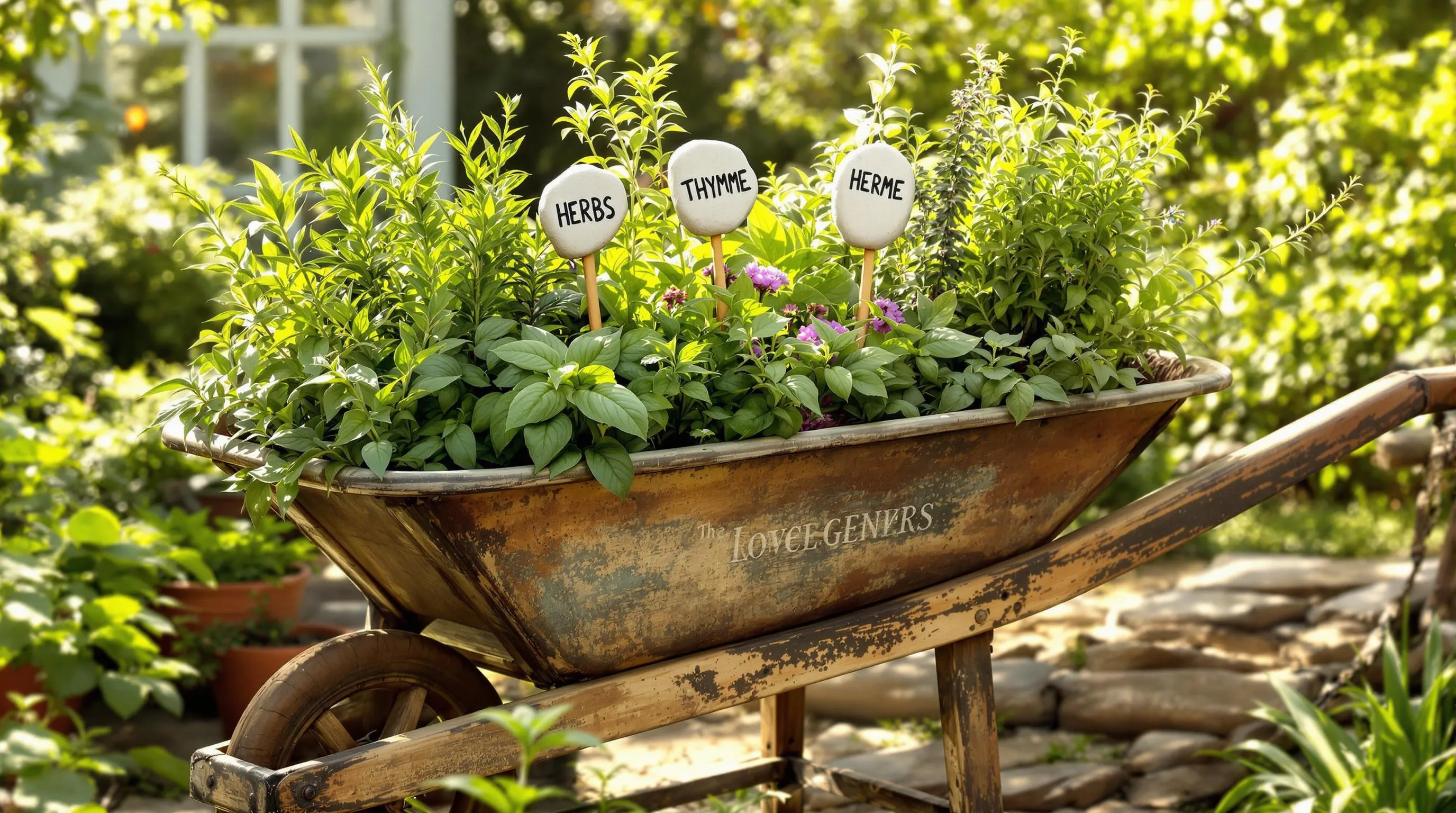
Transform your old wheelbarrow into a practical herb garden that’s both beautiful and functional for your culinary adventures. Kitchen enthusiasts will appreciate having fresh herbs at their fingertips while adding rustic charm to their outdoor space.
Space-Saving Arrangements for Multiple Herbs
Maximize your wheelbarrow’s planting space by creating designated zones for different herb varieties. Place taller herbs like rosemary and sage toward the back of the wheelbarrow, medium-height plants like basil and parsley in the middle, and trailing herbs such as thyme and oregano along the edges where they can cascade down the sides. You can further optimize space by inserting a raised section in the center using an upturned pot covered with soil, creating a tiered effect that accommodates 8-10 different herbs in even a modest-sized wheelbarrow. Consider using herb markers made from painted stones or wooden spoons to identify each plant while adding decorative elements to your culinary garden.
Companion Planting in Wheelbarrow Gardens
Strategically pair herbs that thrive together to create a harmonious and productive wheelbarrow garden. Plant basil near tomatoes (if you include a dwarf variety) to enhance flavor and repel pests. Combine rosemary with sage as they share similar watering needs and Mediterranean growing conditions. Tuck chives near parsley to deter aphids naturally. You’ll find that mint and lemon balm grow vigorously, so contain them in buried pots within your wheelbarrow to prevent them from overwhelming other herbs. This thoughtful arrangement not only maximizes growing success but also creates a beautiful tapestry of textures and scents that’s as pleasing to the eye as it is practical for your kitchen needs.
Succulent Wheelbarrow Displays for Low-Maintenance Gardening
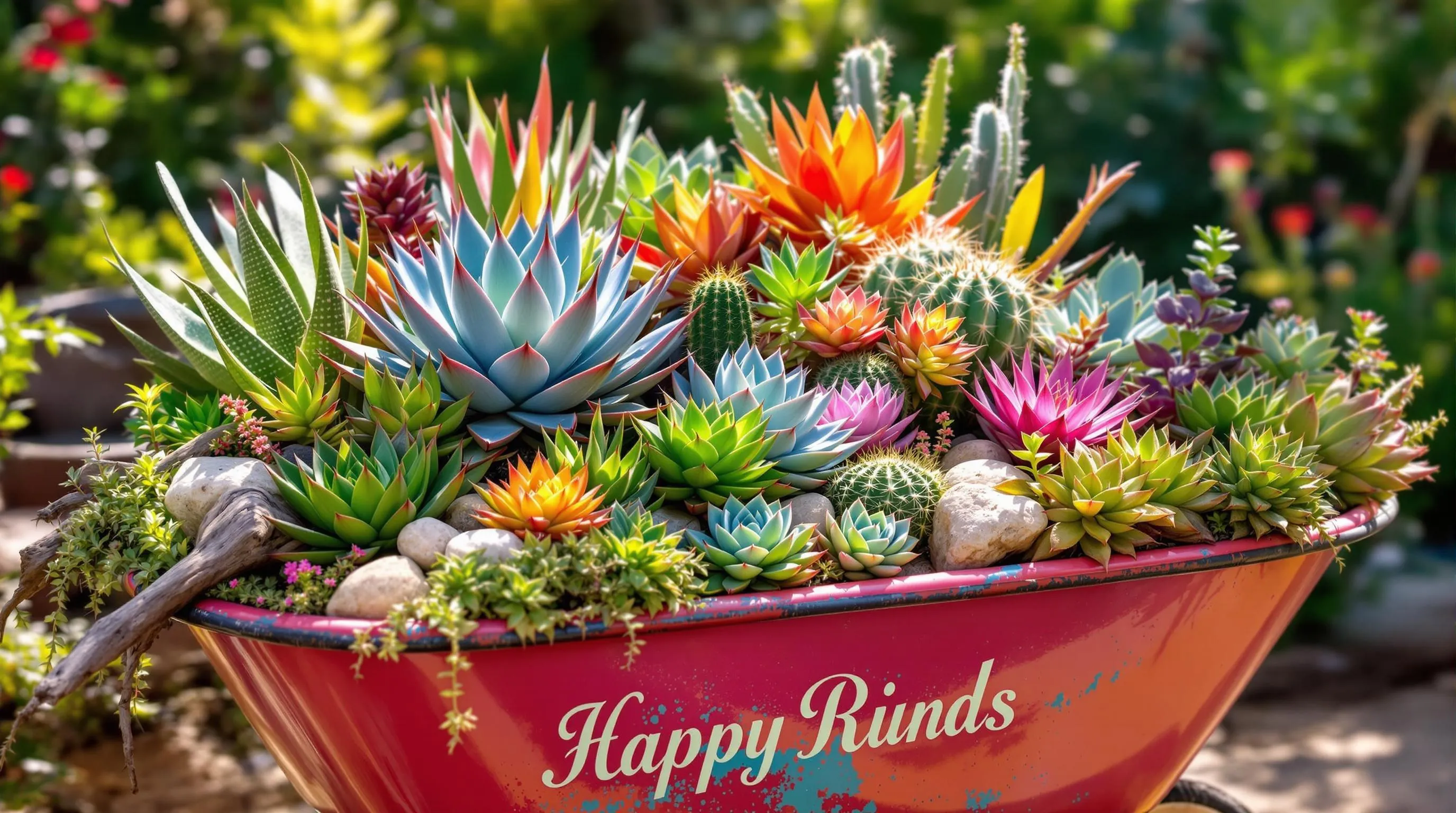
Transforming an old wheelbarrow into a succulent display creates a stunning focal point that requires minimal upkeep. Succulents thrive in the shallow, well-draining environment that wheelbarrows naturally provide, making them perfect partners for busy gardeners or those in drought-prone regions.
Desert-Inspired Arrangements That Thrive in Sun
Create a striking desert industry in your wheelbarrow by combining heat-loving succulents that flourish in full sun exposure. Start with a layer of cactus soil mixed with perlite and small pebbles to ensure excellent drainage. Position statement plants like blue agave or barrel cactus toward the center as focal points. Surround these with lower-growing varieties such as echeverias, sedums, and haworthias. Add visual interest with different colored specimens—mix silver-blue Senecio serpens with the burgundy tones of Echeveria ‘Black Prince’ and the bright greens of Crassula varieties. For authentic desert appeal, incorporate small decorative elements like tumbled glass, polished stones, or bleached driftwood between plantings. Position your wheelbarrow in the sunniest spot in your garden, where it’ll require watering just once every 2-3 weeks in summer and even less frequently during cooler months.
Creating Textural Interest with Varied Succulent Types
Maximize visual impact in your wheelbarrow planter by combining succulents with contrasting textures, shapes, and growth habits. Pair spiky aloe vera with rounded paddle plant (Kalanchoe thyrsiflora) and cascading string of pearls (Senecio rowleyanus) that will trail elegantly over the edges. Include rosette-forming succulents like Echeveria and Sempervivum varieties alongside finger-like Sedum ‘Burrito’ and fuzzy-leaved Kalanchoe tomentosa. Create depth by positioning taller architectural plants like Euphorbia tirucalli ‘Sticks on Fire’ toward the back, medium-sized specimens in the middle, and ground-hugging varieties along the edges. This layered approach creates a living tapestry that changes subtly throughout the seasons. The varied textures not only create visual interest but also ensure your wheelbarrow display remains attractive even when some plants aren’t at their peak. Water only when the soil feels completely dry to touch, typically every 10-14 days during growing season, to prevent the leading cause of succulent failure—overwatering.
Vegetable Growing in Repurposed Wheelbarrows
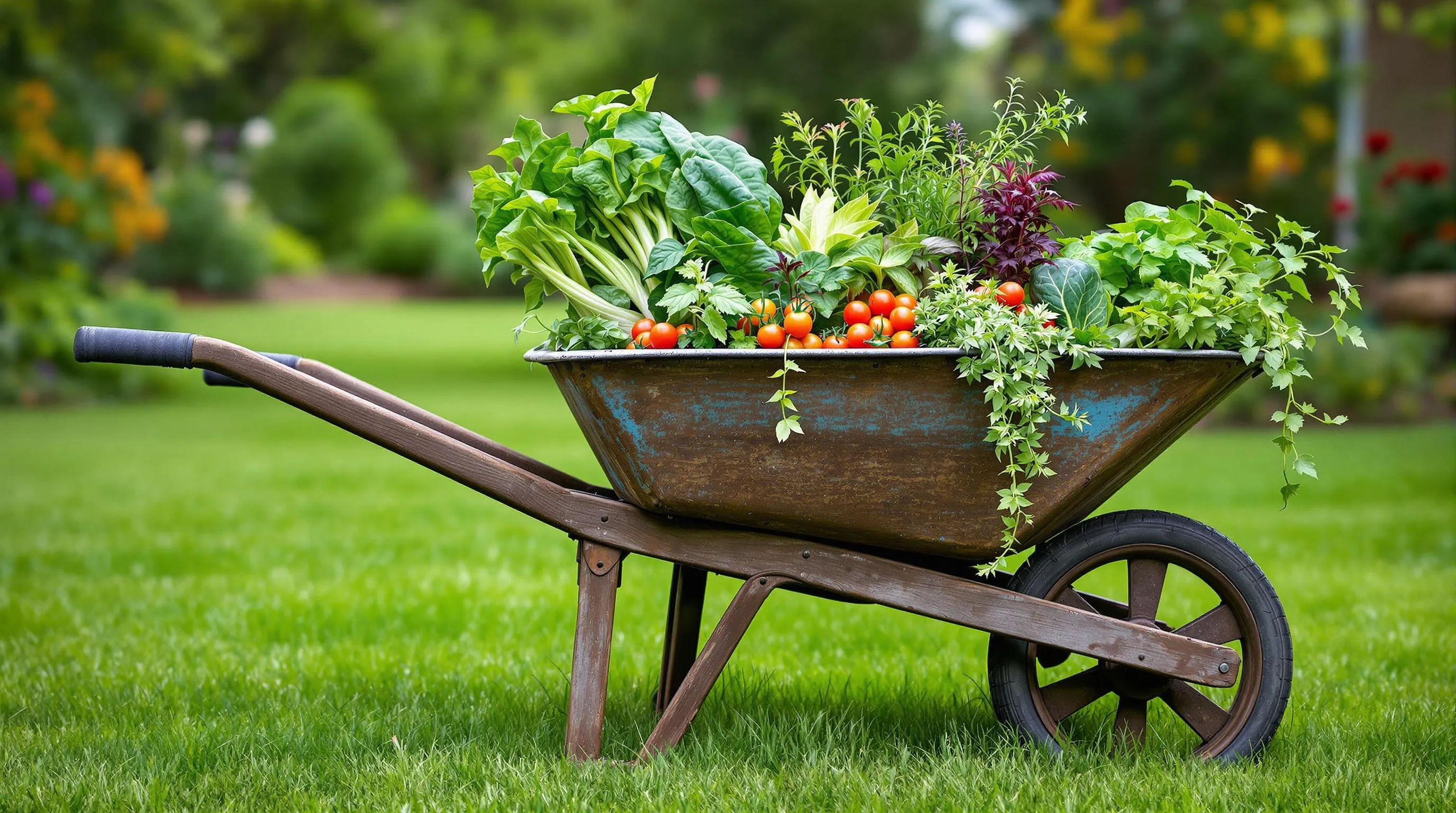
Transform your old wheelbarrow into a productive mini vegetable garden that maximizes growing space while adding rustic charm to your industry. Wheelbarrows provide excellent drainage and mobility, making them perfect vessels for growing your favorite edibles right outside your door.
Space-Efficient Designs for Small Edible Gardens
Create a compact yet productive vegetable garden by arranging plants strategically in your wheelbarrow planter. Place taller vegetables like tomatoes or peppers at the back, medium-height plants like bush beans or compact squash varieties in the middle, and trailing vegetables like cucumbers near the edges to cascade down. For maximum efficiency, integrate vertical supports directly into the wheelbarrow bed—bamboo stakes or small trellises work perfectly for peas, beans, and small cucumber varieties. Consider square-foot gardening techniques by dividing your wheelbarrow into sections using twine or thin wooden dividers, allowing you to grow multiple vegetables in a single container without overcrowding.
Best Vegetables for Container Wheelbarrow Growing
Not all vegetables thrive in container environments, but many flourish in the confined space of a wheelbarrow. Leafy greens like spinach, lettuce, kale, and arugula are perfect choices as they have shallow root systems and can be harvested continuously. Cherry tomatoes, especially determinate varieties, grow wonderfully in wheelbarrows when provided with proper support. Radishes, carrots, and beets perform exceptionally well, particularly in deeper wheelbarrow beds. Herbs like basil, cilantro, and parsley make excellent companions to your vegetables while maximizing space usage. Bush varieties of zucchini, cucumbers, and peppers also thrive in the limited space while producing abundant harvests. For year-round production, rotate cool-season crops like peas and broccoli with warm-season vegetables like eggplants and okra to keep your wheelbarrow garden productive across all seasons.
Seasonal Wheelbarrow Planters for Year-Round Interest
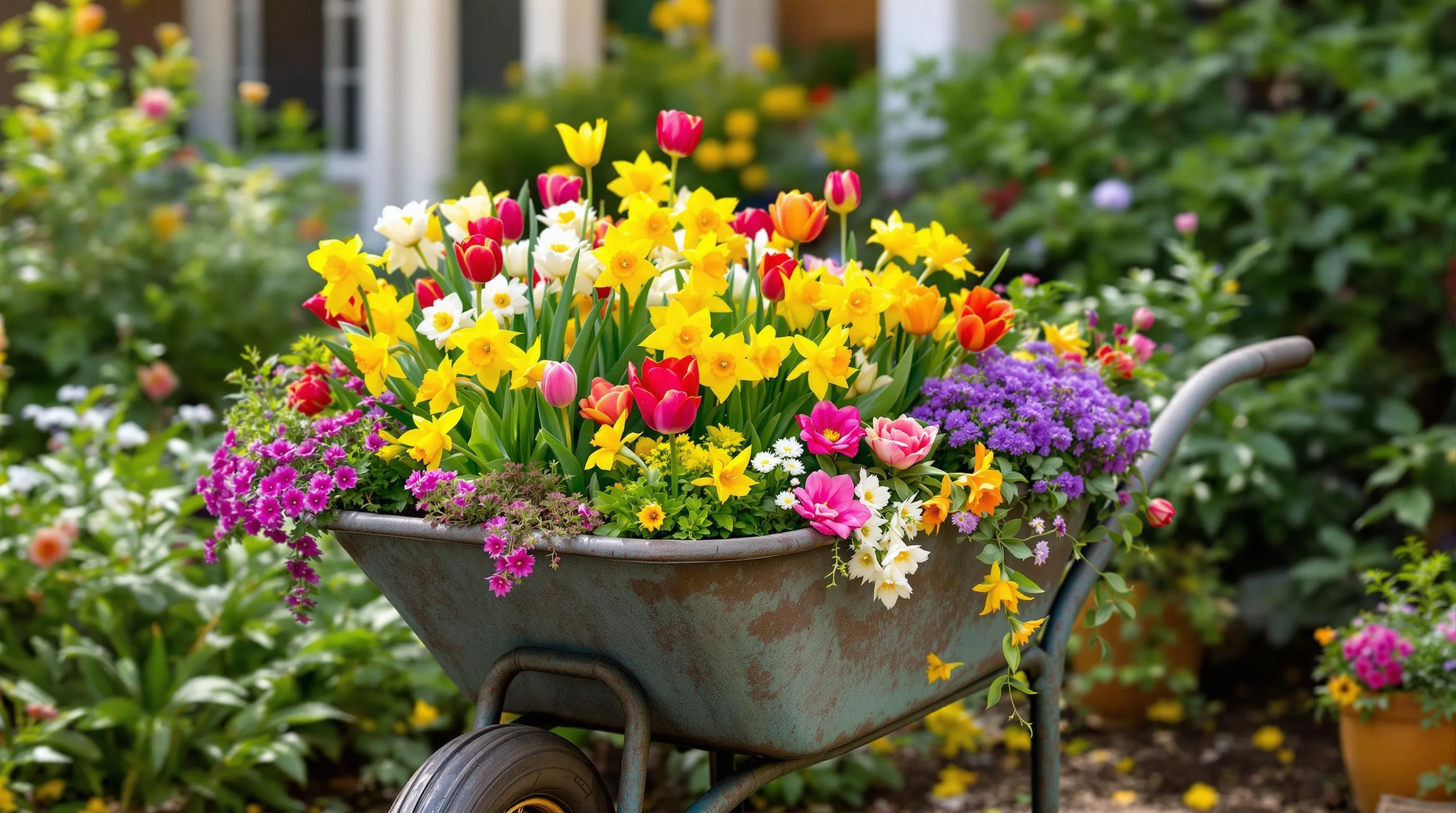
A wheelbarrow planter doesn’t have to be a one-season wonder. With strategic planning and plant selection, you can create displays that evolve throughout the year, ensuring your garden always has a charming focal point regardless of the season.
Spring Bulb Displays That Make a Statement
Transform your wheelbarrow into a springtime sensation with carefully layered bulbs that create waves of color. Start planting in fall by arranging bulbs in layers—place tulips and daffodils (8 inches deep) at the bottom, hyacinths and crocuses (4-6 inches) in the middle, and snowdrops or grape hyacinths (3 inches) near the surface. This “bulb lasagna” technique produces continuous blooms from late winter through spring. Complement your display with cool-weather annuals like pansies, violas, and primroses to fill gaps between emerging bulbs. Position your wheelbarrow near an entryway or patio where the cheerful colors announce spring’s arrival and the sweet fragrance of hyacinths can be fully appreciated.
Winter-Hardy Arrangements for Cold Months
Keep your wheelbarrow planter striking even during winter’s chill with frost-resistant plants and decorative elements. Incorporate evergreen shrubs like dwarf conifers, boxwood, or blue star juniper as anchoring elements that provide structure all winter. Add winter-blooming plants such as hellebores, witch hazel, and winter jasmine for unexpected color. Ornamental cabbages and kales offer beautiful purple and cream foliage that actually intensifies with frost. Enhance the display with red-twig dogwood branches, holly berries, and pinecones for texture and interest. Consider adding outdoor-rated fairy lights to illuminate your winter wheelbarrow during the darkest months, creating a magical glow that brightens your garden when it needs it most.
Vertical Wheelbarrow Garden Ideas for Small Spaces
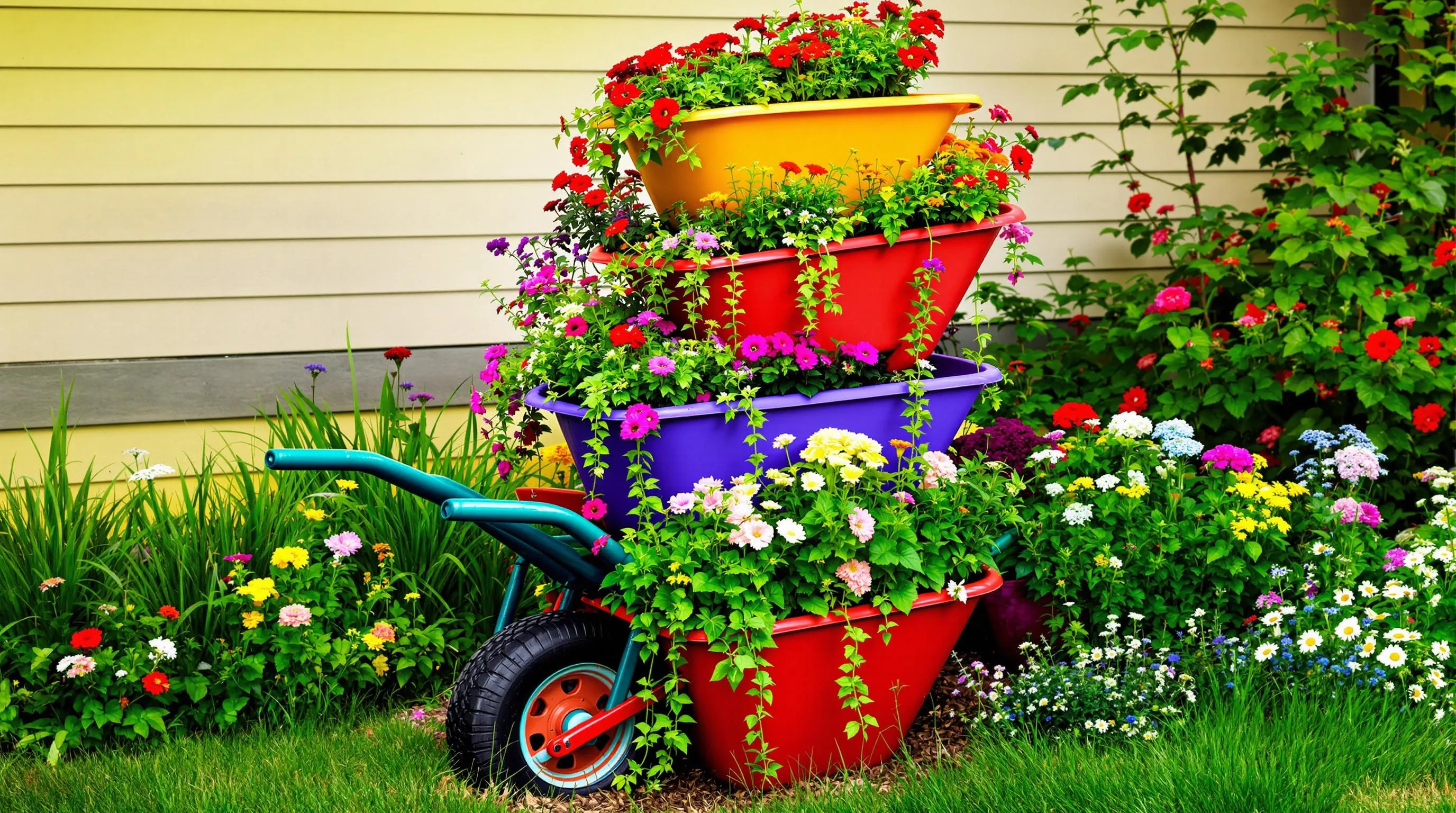
When space is limited, going vertical with your wheelbarrow planter creates stunning visual impact while maximizing your growing area. These vertical garden answers transform ordinary wheelbarrows into space-saving masterpieces that draw the eye upward and make clever use of small garden footprints.
Trellis Additions for Climbing Plants
Transform your wheelbarrow planter into a vertical growing machine by adding a sturdy trellis to the back. Secure a fan-shaped, ladder-style, or grid trellis directly to the wheelbarrow’s handles or embed it in the soil for instant height. Plant vigorous climbers like morning glories, clematis, or scarlet runner beans at the back of your wheelbarrow, then watch as they reach for the sky. Sweet peas and climbing nasturtiums offer both beautiful blooms and delightful fragrance as they wind upward. For edible options, plant sugar snap peas or cucumber vines to create a productive vertical garden. Position the wheelbarrow where these climbing plants can receive proper sunlight while ensuring the trellis is secure enough to support mature plants without toppling.
Stacking Multiple Wheelbarrows for Maximum Impact
Create a show-stopping vertical display by stacking several wheelbarrows of decreasing sizes. Secure a larger wheelbarrow at the base, then position a medium-sized one at an angle above it, finishing with a small wheelbarrow at the top. This tiered arrangement maximizes your planting space while creating a dramatic sculptural element in your garden. Anchor each wheelbarrow securely using cinder blocks, large rocks, or by partially burying the bottom wheelbarrow for stability. Plant cascading flowers like trailing petunias or verbena in the upper wheelbarrows to create a waterfall effect, while using upright plants in the lower levels. Mix in different colored wheelbarrows or paint them in complementary hues to enhance the visual impact of your vertical garden tower.
DIY Wheelbarrow Upcycling Techniques and Finishes
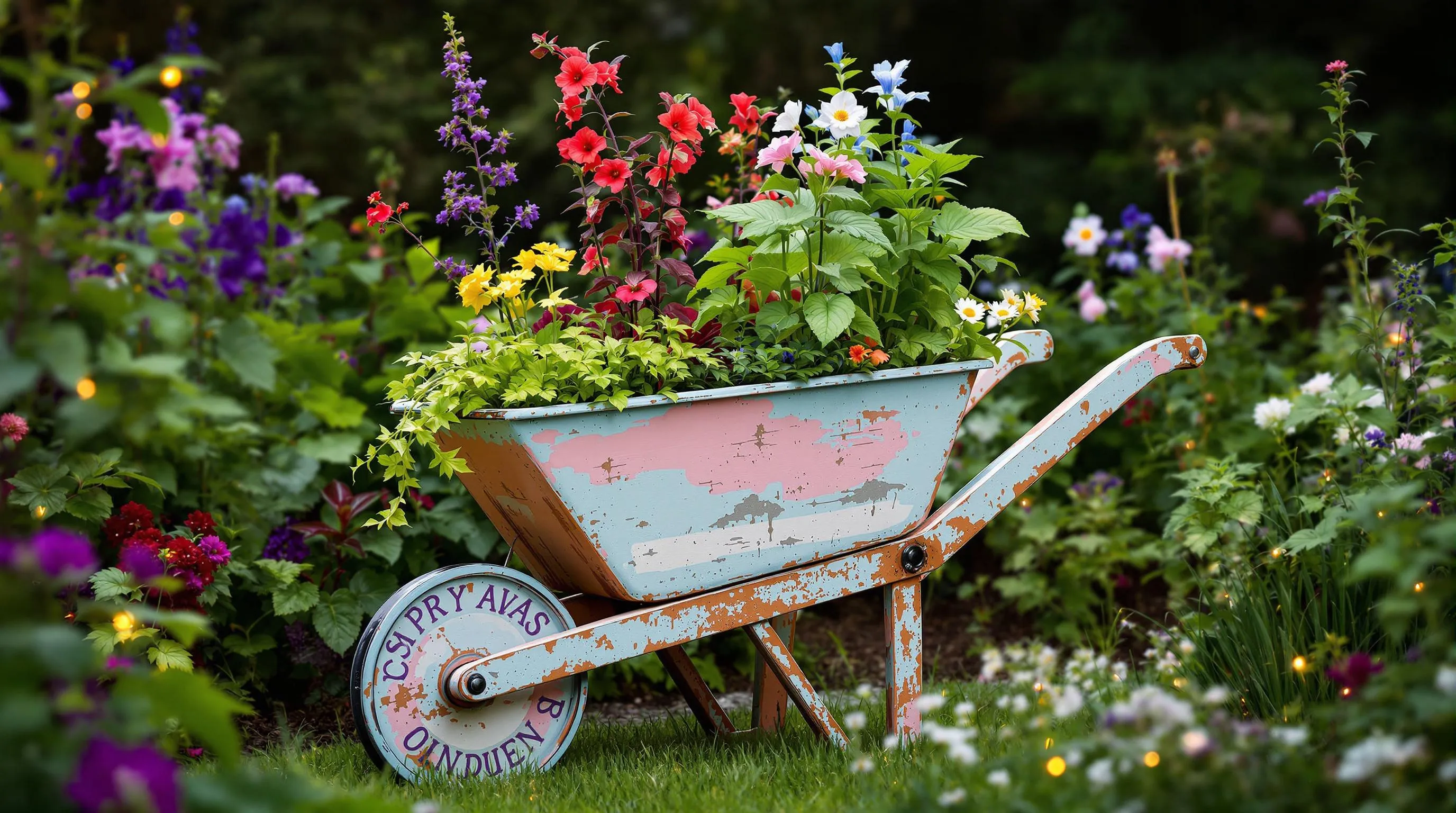
Painting and Distressing for Shabby Chic Appeal
Transform your old wheelbarrow into a shabby chic masterpiece with strategic painting and distressing techniques. Start by sanding the surface to remove rust and create a smooth base for paint adhesion. Apply a primer specifically designed for metal or wood, depending on your wheelbarrow material. Choose chalk paint in pastel hues like duck egg blue, antique white, or sage green for an authentic vintage look. Once dry, use sandpaper to selectively distress edges and corners where natural wear would occur. Apply dark wax to aged areas to enhance the time-worn appearance and seal your work. For wooden wheelbarrows, try the dry brush technique—dip just the tips of your brush in paint and sweep across the grain to let the natural wood peek through for added character.
Adding Decorative Elements and Personal Touches
Elevate your wheelbarrow planter with distinctive decorative elements that showcase your personality. Attach copper or brass accents like vintage handles or corner brackets for a sophisticated contrast against painted surfaces. Consider decoupage techniques using botanical prints or vintage garden imagery on wooden panels. Add waterproof decals or stencil your family name or a favorite garden quote along the sides. Incorporate reclaimed materials like mosaic tile fragments along the rim or attach ornamental metal butterflies and dragonflies that seem to hover over your plants. Weather-resistant ribbons woven through the wheel spokes create movement and color, while strategically placed solar-powered fairy lights transform your planter into a magical evening focal point. These personalized touches not only enhance your wheelbarrow’s charm but also create a truly one-of-a-kind garden feature that tells your story.
Positioning Your Wheelbarrow Planter for Maximum Visual Impact
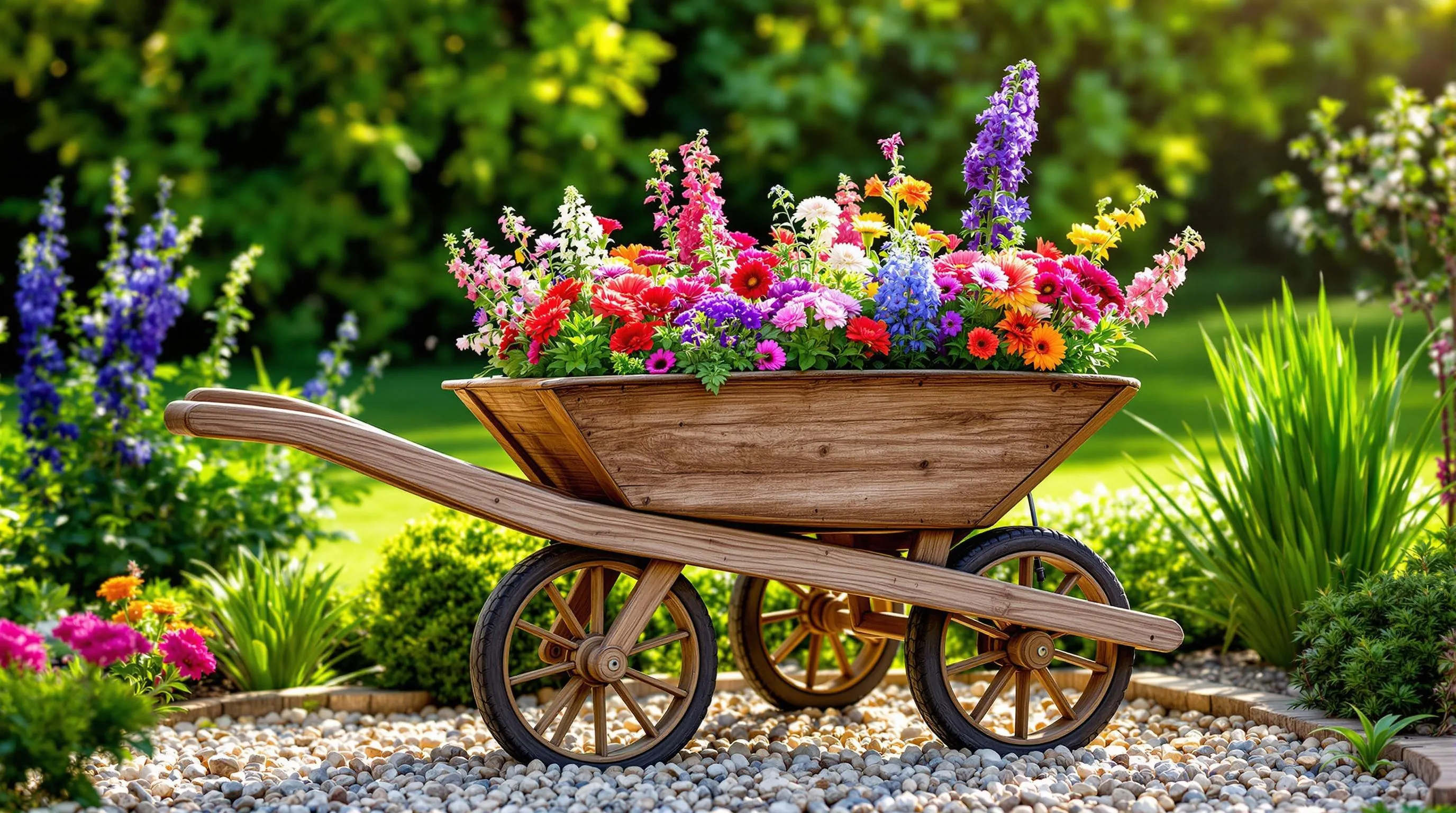
Creating Focal Points in Garden Design
Strategic placement transforms your wheelbarrow planter from a simple container to a stunning focal point. Position your wheelbarrow where it naturally draws the eye—at the end of a garden path, centered in a flower bed, or angled at the corner of a patio. Create visual intrigue by placing it slightly off-center rather than directly in the middle of a space. Elevate your wheelbarrow planter on a small mound or platform to increase visibility and prominence. Consider the background too; placing your wheelbarrow against a fence with climbing plants or near a stone wall adds depth and contextual contrast. For maximum impact, ensure surrounding plants complement rather than compete with your wheelbarrow display, using lower-growing varieties around the base to frame your creation.
Incorporating Wheelbarrow Planters into Different Industry Styles
Your wheelbarrow planter can enhance virtually any garden aesthetic with thoughtful placement and styling. In cottage gardens, position your rustic wooden wheelbarrow among informal flower clusters, allowing some plants to spill over the edges for that charming, unstructured look. For modern landscapes, opt for a sleek metal wheelbarrow placed on a bed of decorative gravel or concrete pavers, filled with architectural plants like ornamental grasses or succulents. In country or farmhouse settings, place your vintage wheelbarrow near other rustic elements like stone walls or split-rail fences to reinforce the theme. Japanese-inspired gardens benefit from a weathered wooden wheelbarrow holding moss and miniature conifers positioned near water features. Mediterranean gardens shine with a sun-bleached wheelbarrow filled with lavender and rosemary placed along gravel pathways. Remember to consider seasonal light patterns—positioning your wheelbarrow where it receives appropriate sunlight for its plants while remaining visible from key viewing areas maximizes both plant health and aesthetic appeal.
Maintaining Your Wheelbarrow Garden Throughout the Seasons
Your wheelbarrow planter isn’t just a decorative element—it’s a living garden that will reward your creativity with beauty throughout the year. With the right care and occasional refreshing these unique containers will continue to charm visitors and bring you joy for seasons to come.
Whether you’ve chosen a cascading flower display succulent arrangement herb garden or vegetable patch your wheelbarrow garden offers endless possibilities for personalization. The versatility of these repurposed treasures makes them perfect for any garden style and space constraint.
Remember that the best wheelbarrow gardens evolve with the seasons adapting to changing light conditions and your own creative inspiration. By maintaining proper drainage refreshing soil annually and rotating plants seasonally you’ll ensure your wheelbarrow remains a stunning focal point that celebrates both gardening innovation and sustainability.

